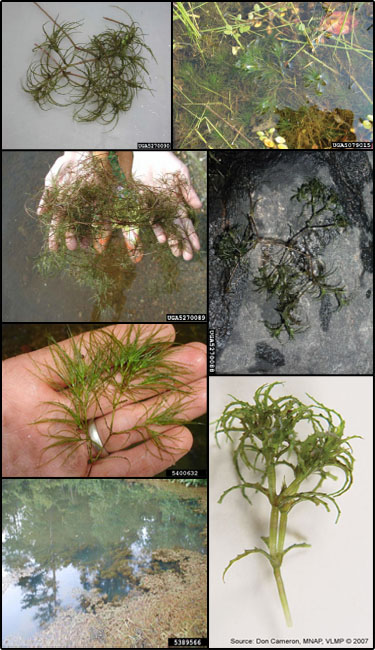Brittleleaf naiad (Najas minor)
 Common Names: Brittle water-nymph, European naiad, naiad
Common Names: Brittle water-nymph, European naiad, naiadDescription: First reported in the United States in the Hudson River in 1934. There was an intentional introduction into the Cayuga Lake, NY in 1935. Reasons for its introduction are unknown but it was encouraged as food for waterfowl in the 1930s.
Habit: Herbaceous, rooted, aquatic annual, brittle; forms dense, bushy, stands.
Leaves: Dark green in color, opposite, about 3.5 cm (1 in) long and very narrow with 7-15 teeth on each side, distinctive serrate basal lobes.
Stems: Reach 1.2 (4 ft) in length; profusely branched near apex; brittle.
Flowers: 1-2 per axil, staminate and pistillate on same plant, very tiny.
Fruit and seeds: Small, 1.5-3.0 mm, develop in the leaf axils. Fruits are slightly curved and have white ladderlike longitudinal rows.
Habitat: Native to Eurasia and Africa. Found in ponds, lakes and slow-moving waters; in depths of up to 4.5 m (15 ft).
Reproduction: By abundant seeds which are eaten by waterfowl; fragments dispersed by boats and currents.
Similar species: Coon's Tail (Ceratophyllum demersum) has whorled leaves; its spiny leaf margins and basal lobes, which are visible without a hand lens.
Monitoring and rapid response: Hand-pulling or cutting for small infestations. Credits: The information provided in this factsheet was gathered from EDDMapS IPANE, the Massachusetts Department of Conservation and Recreation and the Michigan Natural Features Inventory.
Individual species images that appear with a number in a black box are courtesy of the Bugwood.org network (http://www.invasive.org).Individual photo author credits may not be included due to the small display size of the images and subsequent difficulty of reading the provided text. All other images appear courtesy of Google (http://images.google.com).
Common Name: | Brittleleaf naiad |
Scientific Name: | Najas minor |
Family: | Najadaceae (Water-nymph) |
Duration: | Annual |
Habit: | Aquatics |
USDA Symbol: | NAMI |
 View Species Course |
|
